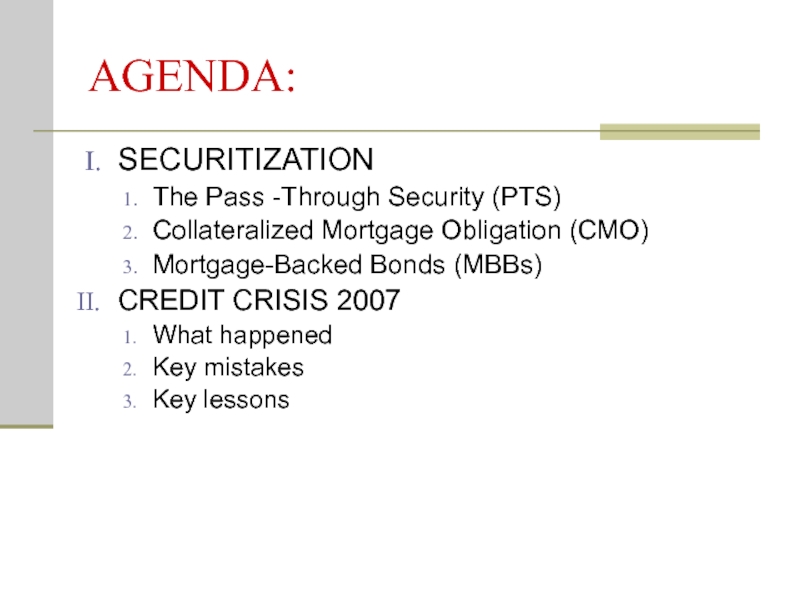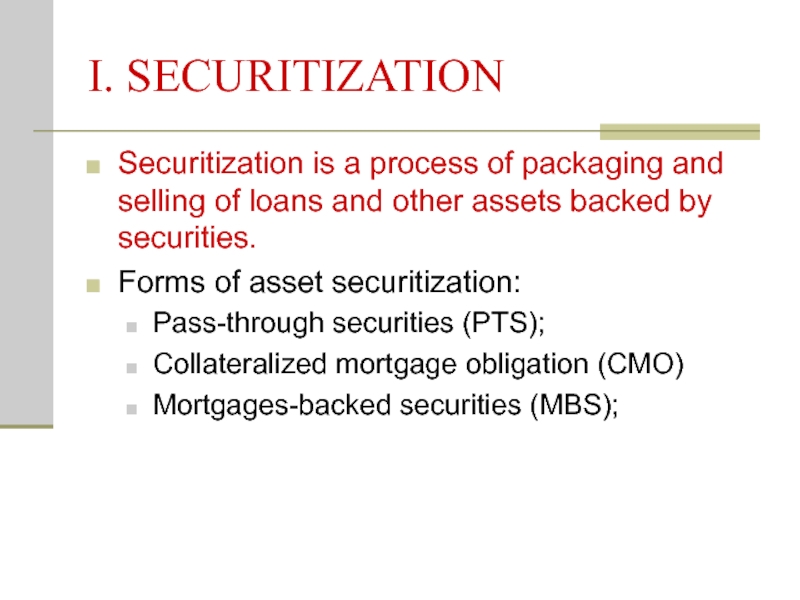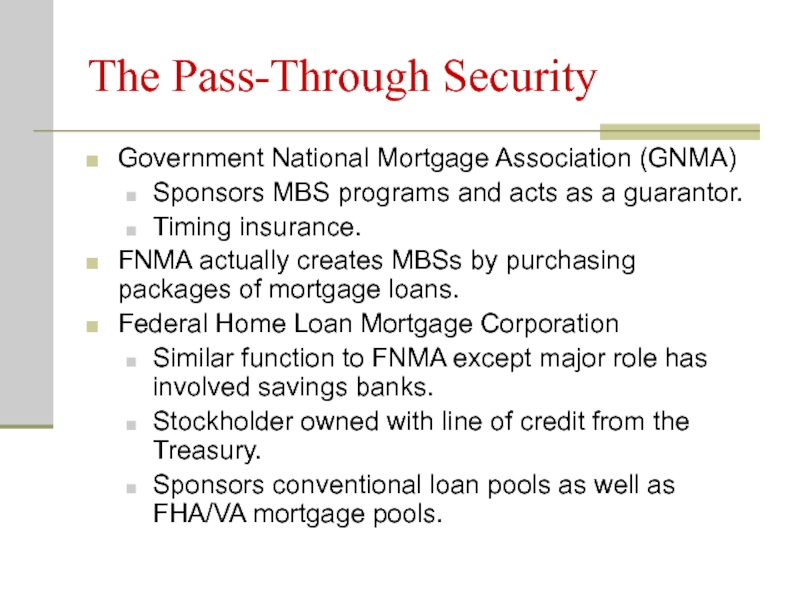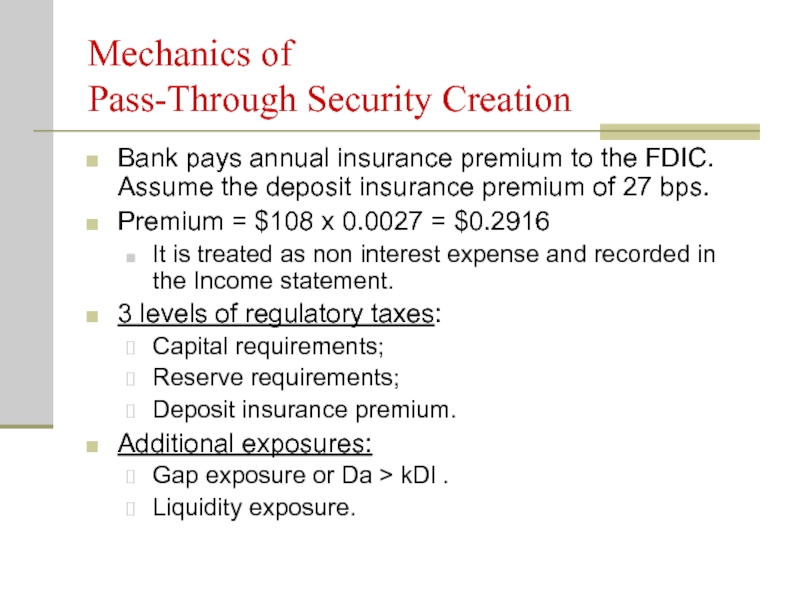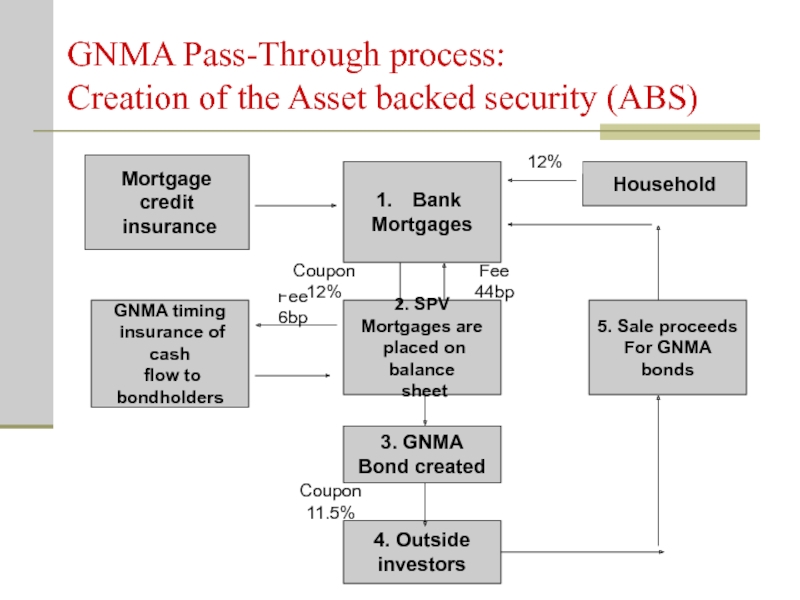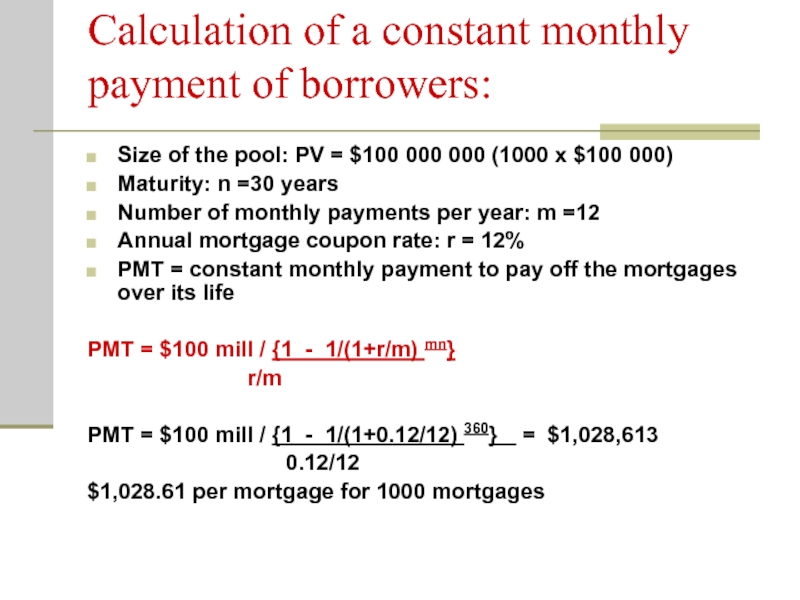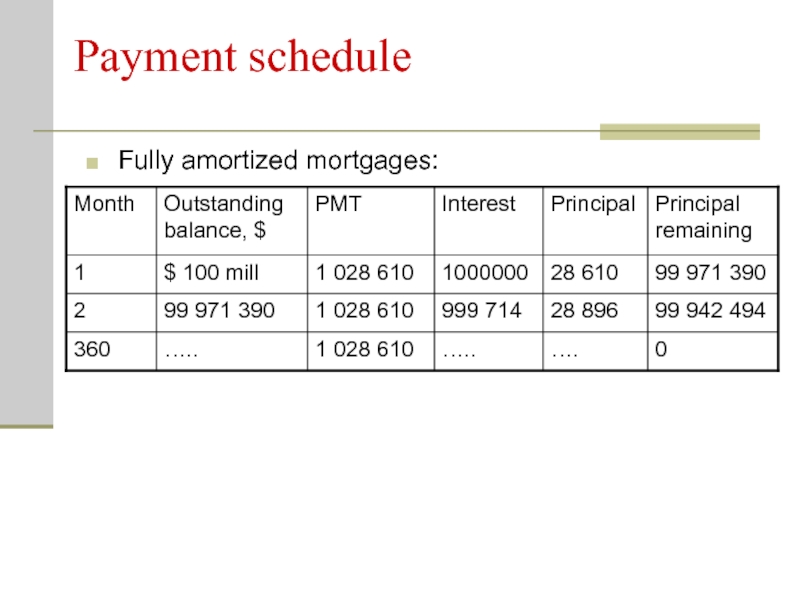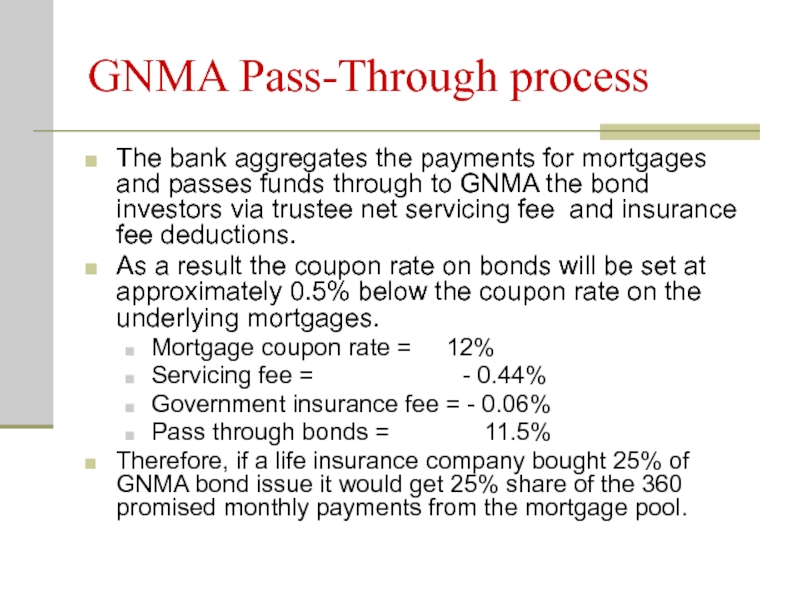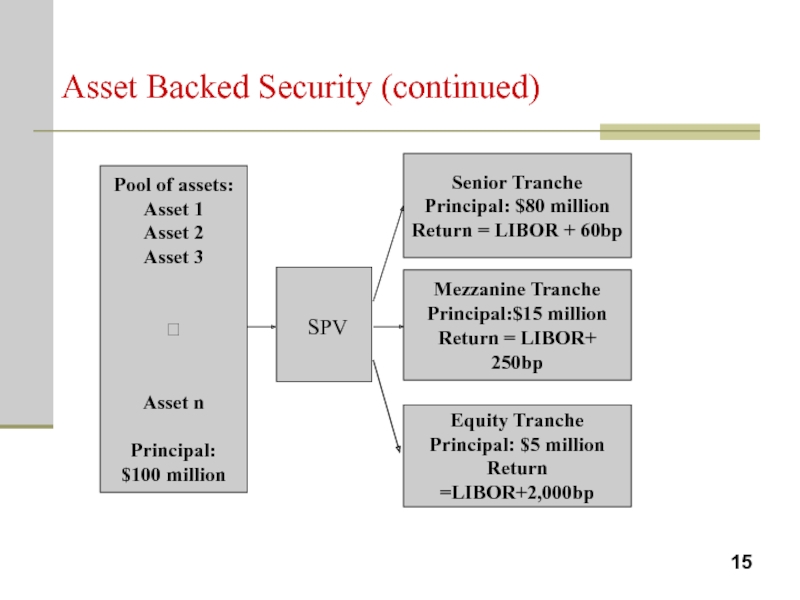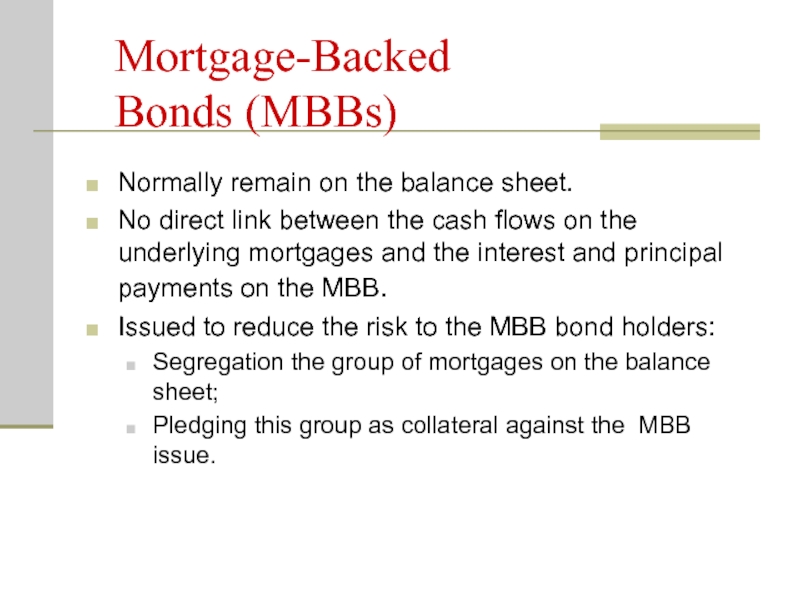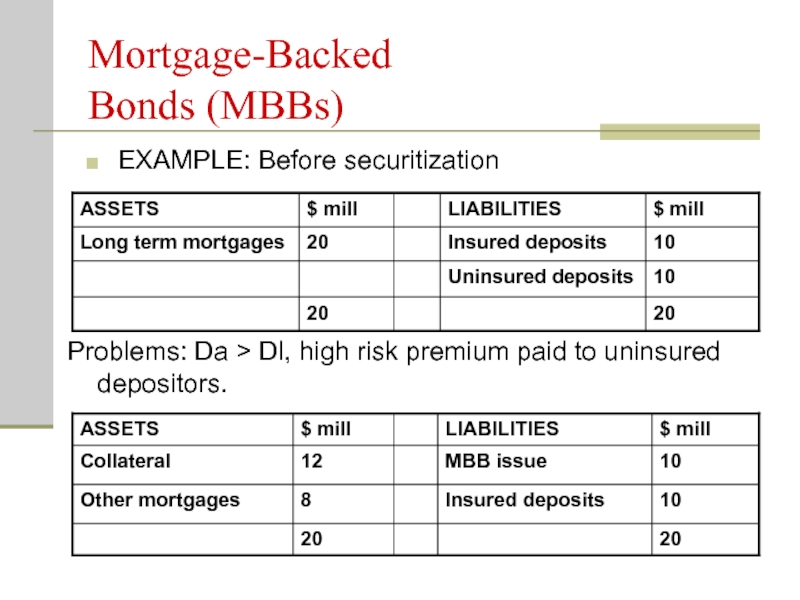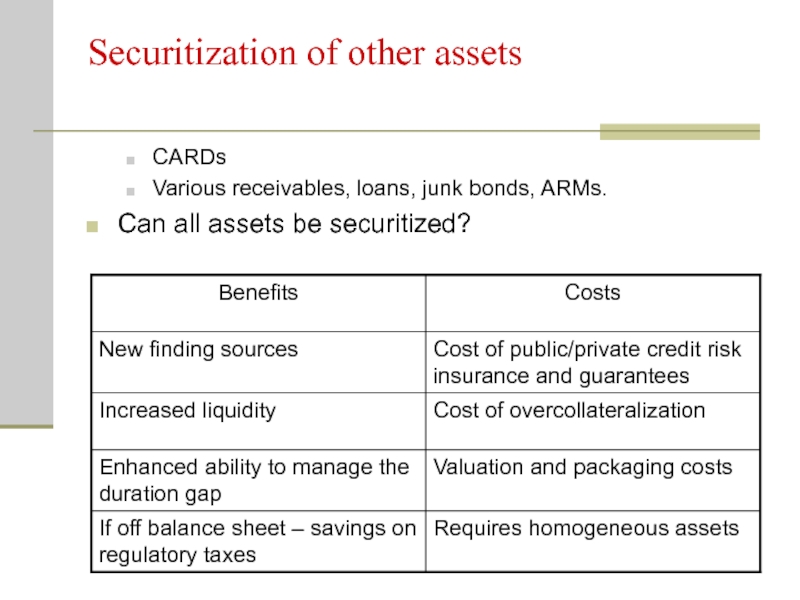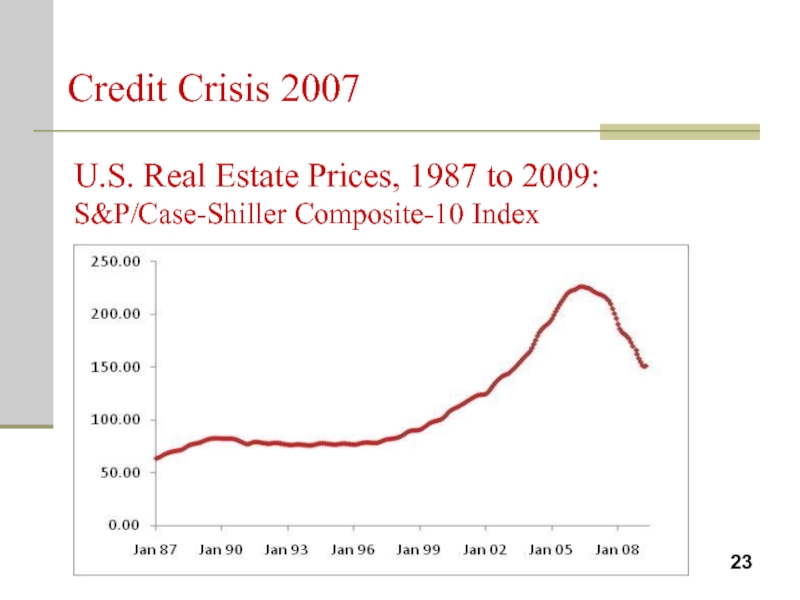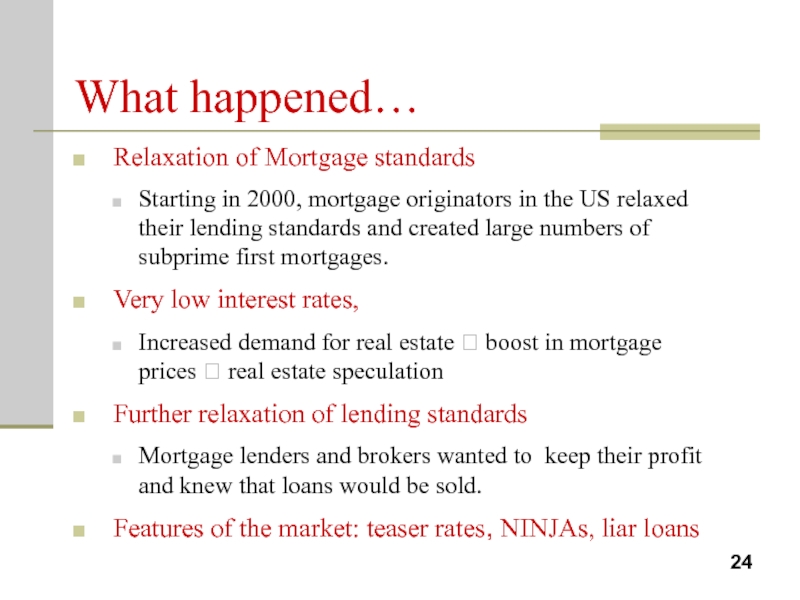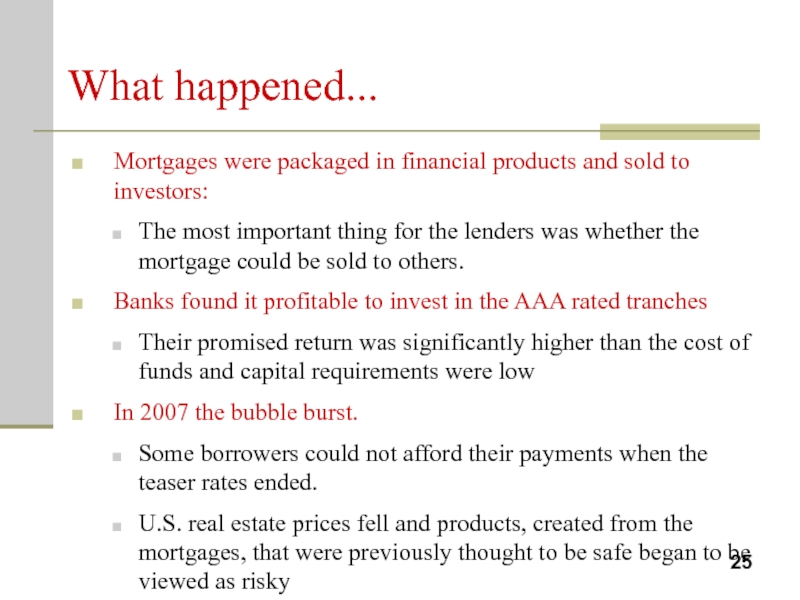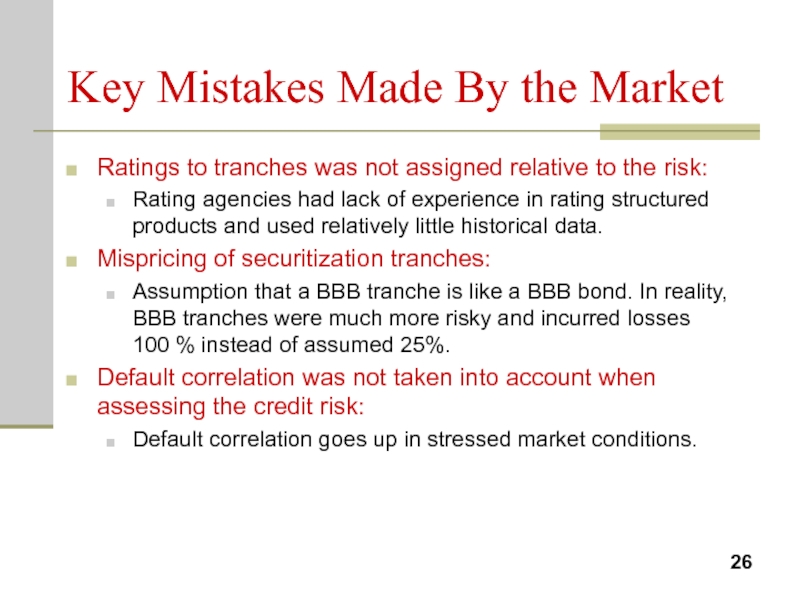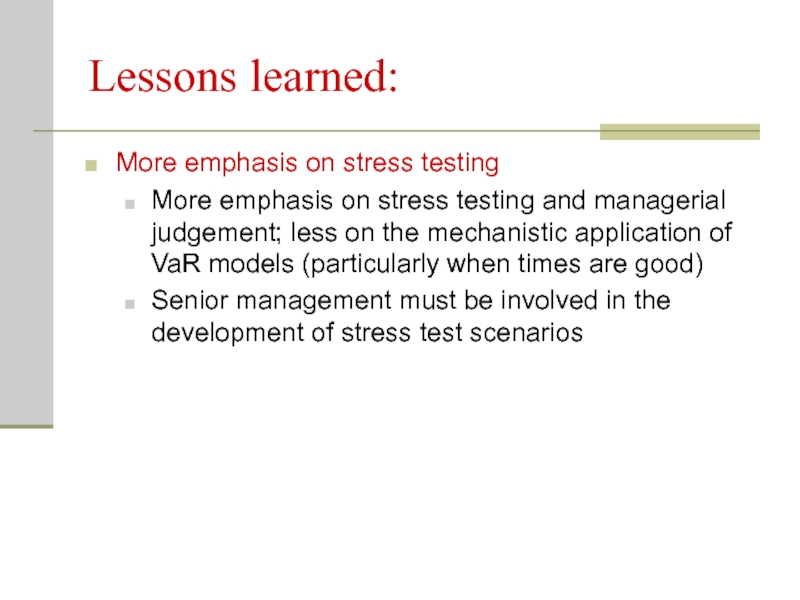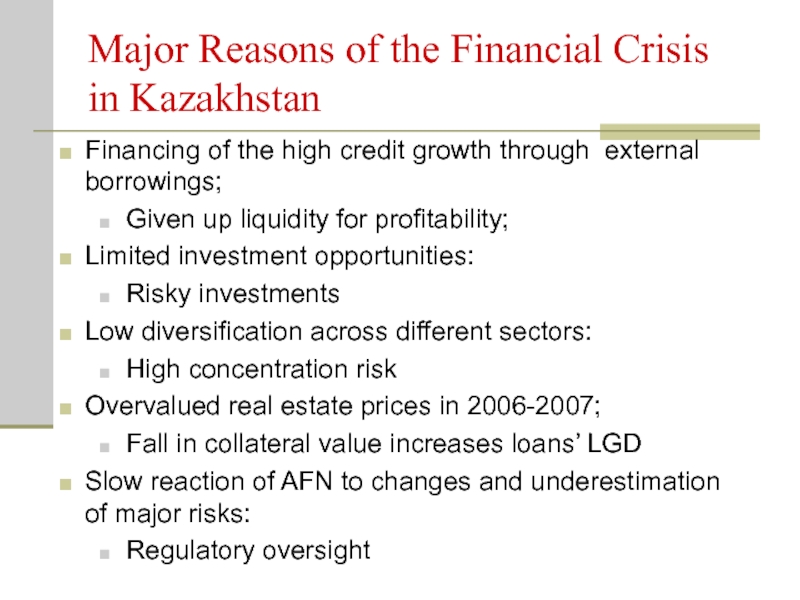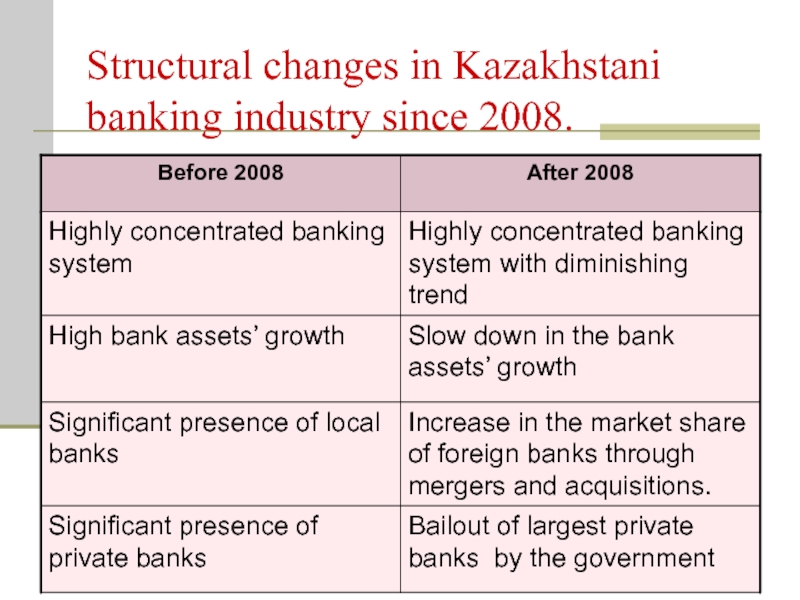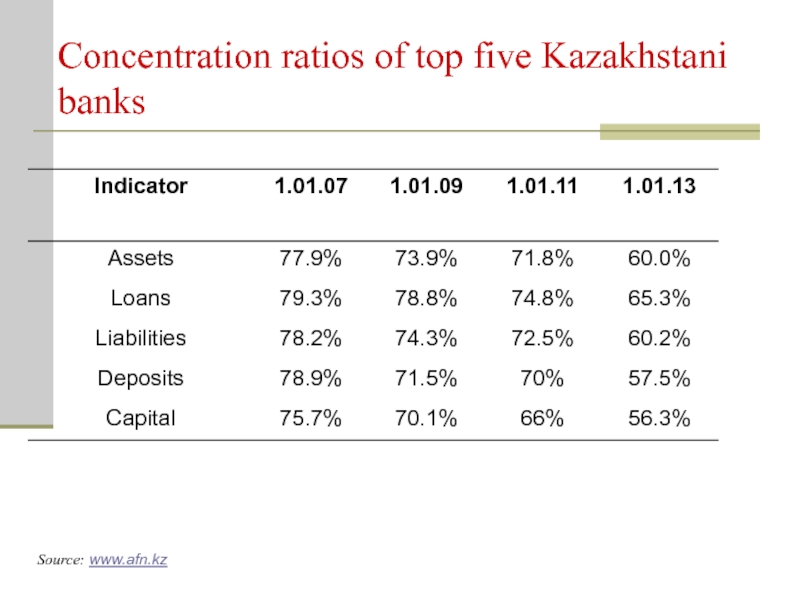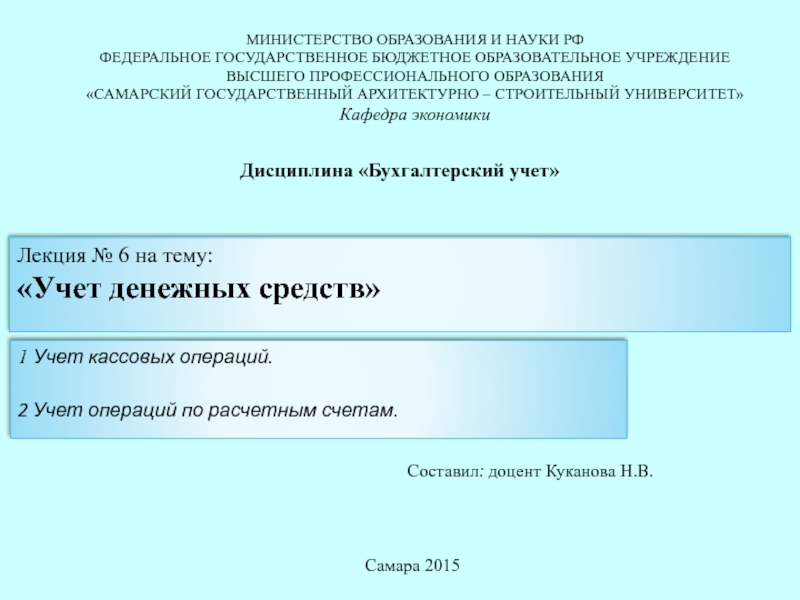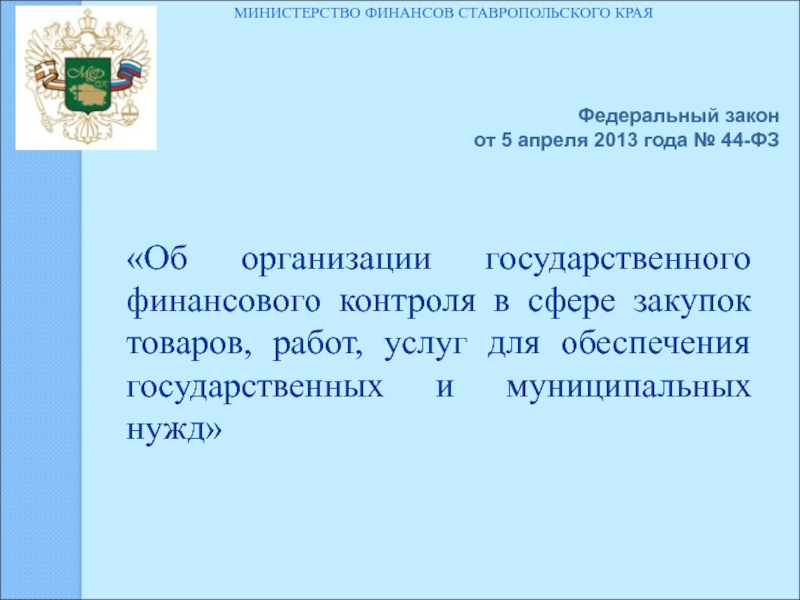- Главная
- Разное
- Дизайн
- Бизнес и предпринимательство
- Аналитика
- Образование
- Развлечения
- Красота и здоровье
- Финансы
- Государство
- Путешествия
- Спорт
- Недвижимость
- Армия
- Графика
- Культурология
- Еда и кулинария
- Лингвистика
- Английский язык
- Астрономия
- Алгебра
- Биология
- География
- Детские презентации
- Информатика
- История
- Литература
- Маркетинг
- Математика
- Медицина
- Менеджмент
- Музыка
- МХК
- Немецкий язык
- ОБЖ
- Обществознание
- Окружающий мир
- Педагогика
- Русский язык
- Технология
- Физика
- Философия
- Химия
- Шаблоны, картинки для презентаций
- Экология
- Экономика
- Юриспруденция
Securitization and credit crises презентация
Содержание
- 1. Securitization and credit crises
- 2. Credit risk transfer instruments Loan Sales Securitization
- 3. AGENDA: SECURITIZATION The Pass -Through Security (PTS)
- 4. I. SECURITIZATION Securitization is a process of
- 5. The Pass-Through Security Government National Mortgage Association
- 6. Major Benefits of Securitisation: lower cost
- 7. Incentives and Mechanics of Pass-Through Security
- 8. Mechanics of Pass-Through Security Creation Bank
- 9. GNMA Pass-Through process: Creation of the Asset
- 10. Calculation of a constant monthly payment of
- 11. Payment schedule Fully amortized mortgages:
- 12. GNMA Pass-Through process The bank aggregates the
- 13. Further Incentives The attractiveness of these bonds
- 14. Effects of prepayments Prepayment risk is the
- 15. Asset Backed Security (continued)
- 16. The Waterfall Equity Tranche 1st loss 2nd
- 17. Collateralized Mortgage Obligations (ABS CMO) were created
- 18. Collateralized Mortgage Obligation (CMO) Prepayment effects
- 19. Mortgage-Backed Bonds (MBBs) Normally remain on
- 20. Mortgage-Backed Bonds (MBBs) EXAMPLE: Before securitization
- 21. Mortgage-Backed Bonds (MBBs) Weaknesses: Tied up
- 22. Securitization of other assets CARDs Various
- 23. U.S. Real Estate Prices, 1987 to 2009: S&P/Case-Shiller Composite-10 Index Credit Crisis 2007
- 24. What happened… Relaxation of Mortgage standards Starting
- 25. What happened... Mortgages were packaged in financial
- 26. Key Mistakes Made By the Market Ratings
- 27. Key Mistakes Made By the Market Regulators
- 28. Lessons learned: Ensure transparency of complex products.
- 29. Lessons learned: More emphasis on stress testing
- 30. Major Reasons of the Financial Crisis
- 31. Why Financial Crisis in Kazakhstan was not
- 32. Real Estate Price Dynamic in Kazakhstan
- 33. Structural changes in Kazakhstani banking industry since 2008.
- 34. Concentration ratios of top five Kazakhstani banks Source: www.afn.kz
- 35. Market share of local bank vs market
- 36. Kazakhstan Banks’ Nationalization
Слайд 1SECURITIZATION AND CREDIT CRISIS 2007
FINANCIAL INSTITUTIONS MANAGEMENT
Saunders, A., Chapter 27
Hull, J.,
Слайд 2Credit risk transfer instruments
Loan Sales
Securitization
Credit Derivatives
Traditional
Distress debt
Sovereign debt
Pass
Collateralized Debt Obligations
Mortgage – Backed Securities
Synthetic structured products
Слайд 3AGENDA:
SECURITIZATION
The Pass -Through Security (PTS)
Collateralized Mortgage Obligation (CMO)
Mortgage-Backed Bonds (MBBs)
CREDIT CRISIS
What happened
Key mistakes
Key lessons
Слайд 4I. SECURITIZATION
Securitization is a process of packaging and selling of loans
Forms of asset securitization:
Pass-through securities (PTS);
Collateralized mortgage obligation (CMO)
Mortgages-backed securities (MBS);
Слайд 5The Pass-Through Security
Government National Mortgage Association (GNMA)
Sponsors MBS programs and acts
Timing insurance.
FNMA actually creates MBSs by purchasing packages of mortgage loans.
Federal Home Loan Mortgage Corporation
Similar function to FNMA except major role has involved savings banks.
Stockholder owned with line of credit from the Treasury.
Sponsors conventional loan pools as well as FHA/VA mortgage pools.
Слайд 6Major Benefits of Securitisation:
lower cost of funding due to the enhanced
capital saving from the sale of assets – decreases the minimum earnings required to ensure an adequate return to shareholders
important source of fee income
Investors enjoy the higher return from the mortgage market
Слайд 7Incentives and Mechanics of
Pass-Through Security Creation
Example: Assume that Bank has
The total size of new mortgage pool is $100mill=1000*100 000
Capital adequacy requirements (risk weight is 35%) =100*0.08*0.35=$2.8mill
Minimum reserve requirements 10 % of deposits:
Assets Liabilities
Cash = 0.1 * D Deposits (D) = x
Mortgages = 100 Equity = 2.8
0.1D+100 = 2.8+D
Therefore, D=108 mill.
Asset Liabilities
Cash = 10.8 Deposits = 108
Mortgages = 100 Capital = 2.8
Total = 110.8 Total = 110.8
Слайд 8Mechanics of
Pass-Through Security Creation
Bank pays annual insurance premium to the
Premium = $108 x 0.0027 = $0.2916
It is treated as non interest expense and recorded in the Income statement.
3 levels of regulatory taxes:
Capital requirements;
Reserve requirements;
Deposit insurance premium.
Additional exposures:
Gap exposure or Da > kDl .
Liquidity exposure.
Слайд 9GNMA Pass-Through process:
Creation of the Asset backed security (ABS)
Mortgage credit
insurance
Bank
Mortgages
2.
Mortgages are
placed on balance
sheet
3. GNMA
Bond created
4. Outside
investors
GNMA timing
insurance of cash
flow to
bondholders
5. Sale proceeds
For GNMA bonds
Fee 6bp
Fee 44bp
Coupon 12%
Coupon 11.5%
Household
12%
Слайд 10Calculation of a constant monthly payment of borrowers:
Size of the
Maturity: n =30 years
Number of monthly payments per year: m =12
Annual mortgage coupon rate: r = 12%
PMT = constant monthly payment to pay off the mortgages over its life
PMT = $100 mill / {1 - 1/(1+r/m) mn}
r/m
PMT = $100 mill / {1 - 1/(1+0.12/12) 360} = $1,028,613
0.12/12
$1,028.61 per mortgage for 1000 mortgages
Слайд 12GNMA Pass-Through process
The bank aggregates the payments for mortgages and passes
As a result the coupon rate on bonds will be set at approximately 0.5% below the coupon rate on the underlying mortgages.
Mortgage coupon rate = 12%
Servicing fee = - 0.44%
Government insurance fee = - 0.06%
Pass through bonds = 11.5%
Therefore, if a life insurance company bought 25% of GNMA bond issue it would get 25% share of the 360 promised monthly payments from the mortgage pool.
Слайд 13Further Incentives
The attractiveness of these bonds to investors. In particular, investors
1. Default risk of the borrowers.
If the prices on houses fall rapidly, a homeowner can leave the low-valued mortgage. This might expose the mortgage bondholders to loses unless there are external guarantors.
2. Default risk of Bank/ SPV
Even if the bank or trustee bankrupt, GNMA would bear the costs of making the promised payments in full and on time to GNMA bondholders (due to GNMA insurance).
Assumed LGD = 25%
Слайд 14Effects of prepayments
Prepayment risk is the risk that the loan will
Sources of risk:
Mortgage refinancing due to decrease in interest rates
Housing Turnover
Good news effects
Lower market yields increase present value of cash flows.
Principal received sooner.
Bad news effects
Fewer interest payments in total.
Reinvestment at lower rates.
Слайд 16The Waterfall
Equity Tranche
1st loss
2nd loss, if 1st loss is more than
3d loss, if 2nd loss is more than 20%
Слайд 17Collateralized Mortgage Obligations (ABS CMO) were created to manage the prepayment
Assets
Senior Tranche (80%)
AAA
Mezzanine Tranche (15%)
BBB
Equity Tranche (5%)
Not Rated
Senior Tranche (65%)
AAA
Mezzanine Tranche (25%) BBB
Equity Tranche (10%)
The mezzanine tranche is repackaged with other mezzanine tranches
Слайд 18Collateralized Mortgage
Obligation (CMO)
Prepayment effects differ across tranches (classes)
R Class
Improves marketability
Mezzanine
Tranche
A
B
C
Mezzanine
Tranche
B
C
$2.5 mill
P = $1 500 000
C = $291 667
$1208333
C = $ 333 333
C= $375 000
P=500 000
C = $ 333 333
C = $375 000
Слайд 19Mortgage-Backed
Bonds (MBBs)
Normally remain on the balance sheet.
No direct link between
Issued to reduce the risk to the MBB bond holders:
Segregation the group of mortgages on the balance sheet;
Pledging this group as collateral against the MBB issue.
Слайд 20Mortgage-Backed
Bonds (MBBs)
EXAMPLE: Before securitization
Problems: Da > Dl, high risk
Слайд 21Mortgage-Backed
Bonds (MBBs)
Weaknesses:
Tied up mortgages on the balance sheet for a
Increases the illiquidity of the asset portfolio;
Over-collateralization;
Liability for capital adequacy and reserve requirement taxes.
Слайд 22Securitization of other assets
CARDs
Various receivables, loans, junk bonds, ARMs.
Can all assets
Слайд 23U.S. Real Estate Prices, 1987 to 2009: S&P/Case-Shiller Composite-10 Index
Credit Crisis
Слайд 24What happened…
Relaxation of Mortgage standards
Starting in 2000, mortgage originators in the
Very low interest rates,
Increased demand for real estate ? boost in mortgage prices ? real estate speculation
Further relaxation of lending standards
Mortgage lenders and brokers wanted to keep their profit and knew that loans would be sold.
Features of the market: teaser rates, NINJAs, liar loans
Слайд 25What happened...
Mortgages were packaged in financial products and sold to investors:
The
Banks found it profitable to invest in the AAA rated tranches
Their promised return was significantly higher than the cost of funds and capital requirements were low
In 2007 the bubble burst.
Some borrowers could not afford their payments when the teaser rates ended.
U.S. real estate prices fell and products, created from the mortgages, that were previously thought to be safe began to be viewed as risky
Слайд 26Key Mistakes Made By the Market
Ratings to tranches was not assigned
Rating agencies had lack of experience in rating structured products and used relatively little historical data.
Mispricing of securitization tranches:
Assumption that a BBB tranche is like a BBB bond. In reality, BBB tranches were much more risky and incurred losses 100 % instead of assumed 25%.
Default correlation was not taken into account when assessing the credit risk:
Default correlation goes up in stressed market conditions.
Слайд 27Key Mistakes Made By the Market
Regulators required to retain only from
Crisis showed that it was not enough to control the risk appetite of originators.
Regulators and investors did not understand the overall risk of FIs:
Over-the-counter derivatives’ positions were hidden off the balance sheet
Слайд 28Lessons learned:
Ensure transparency of complex products.
Creators of the products should
Over-the-counter derivatives should be:
Daily marked to market;
Put on the balance sheet
FIs need to create models to assess the risks
Most financial institutions did not have models to value the tranches they traded. Without a valuation model risk management is virtually impossible
Слайд 29Lessons learned:
More emphasis on stress testing
More emphasis on stress testing and
Senior management must be involved in the development of stress test scenarios
Слайд 30Major Reasons of the Financial Crisis
in Kazakhstan
Financing of the high
Given up liquidity for profitability;
Limited investment opportunities:
Risky investments
Low diversification across different sectors:
High concentration risk
Overvalued real estate prices in 2006-2007;
Fall in collateral value increases loans’ LGD
Slow reaction of AFN to changes and underestimation of major risks:
Regulatory oversight
Слайд 31Why Financial Crisis in Kazakhstan was not so severe as in
Proportion of foreign banks was relatively low.
63% of all market belonged to the 4 largest KZ banks
Amount of mortgages for securitization was still not high enough to practice active securitization.
Слайд 35Market share of local bank vs market share of banks with
Source: www.afn.kz
All data as of January 1 of the given year.


